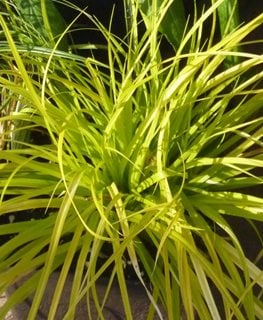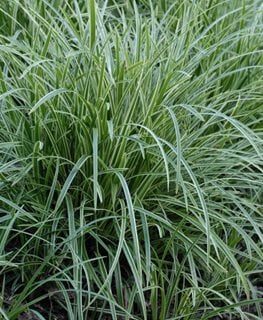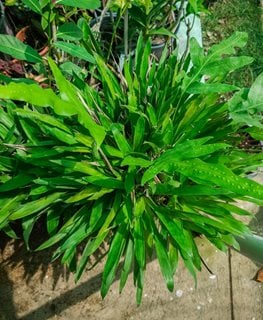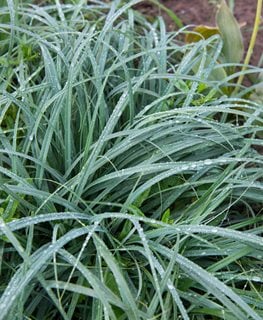HOW TO GROW & CARE FOR SEDGE (CAREX)
This versatile low-maintenance perennial with grass-like foliage has many uses in the landscape
'Evergold' sedge. Photo: Proven Winners
Sedge (Carex) is an ornamental perennial that is grown for the strappy or thin grass-like foliage. This cool-season plant is in the sedge family, Cyperaceae, which is characterized by triangular-shaped stems.
The vast genus of Carex comprises over 2,000 species of sedge, which can be found across the world growing in wetlands, bogs, along stream banks and ponds, and other wet areas. Though there are many types of sedges, Carex is regarded as the only true sedge.
Sedges are often referred to as ornamental grasses even though they are not true grasses. These small to medium-sized grass-like plants add fine texture and structure to the landscape, and are often used as a low-maintenance alternative to traditional turf lawns.
Sedges are tolerant of a range of growing conditions and is a versatile low-maintenance plant for beds, borders, and containers. Learn how to grow and use sedges in your landscape.
On this page: Basics | Planting | Care | Pictures | Frequently Asked Questions | Landscaping Ideas
On this page:
SEDGE BASICS
Botanical name:
Carex spp.
Plant type:
Perennial that grows from rhizomes, stolons, or clumping tufts
Zones:
3-9, depending on the species
Exposure:
Partial shade to full shade, with some species tolerating full sun
Habit:
Compact, upright, arching, clumping or spreading habit
Height/Spread:
6 to 36 inches tall, 12 to 36 inches wide, depending on the variety
Bloom time:
Mid-spring to early summer
Flowers:
Short flower stalks produce brown or beige seed heads that are most often inconspicuous, with some being showier.
Foliage:
Sedges are grown primarily for the ornamental foliage. Leaves can be thin and wire-like or wider and lance-shaped, occurring in shades of green, blue, gold, chartreuse, orange, brown, or variegated. Fall color is insignificant.
Wildlife benefits:
Seeds and pollen of Carex plants are a food source for small mammals, birds, pollinators, and other beneficial insects, and a larval food source for caterpillars. Foliage provides shelter and nesting sites for birds and other wildlife.
Is sedge toxic?
Sedge is not toxic to humans or pets, though ingestion may cause mild digestive upset.
Are sedges deer resistant?
Sedges are resistant to deer browse, though deer may graze on plants if other food sources are scarce.
HOW TO PLANT SEDGE
When to plant:
Plant sedge during milder months in spring or fall to avoid stress from extreme heat or cold.
Where to plant:
Choose a site with partial shade to full shade and rich, well-draining soil. Some sedges are tolerant of full sun, so research individual light needs before planting.
How to plant:
Loosen soil in the planting area and amend with compost or other rich organic matter, if needed. Dig a hole twice as wide and the same depth than the root ball. Remove plant from the nursery container and tease out roots if potbound. Place in the hole so the top of the root ball is level or slightly higher than the surrounding soil. Fill in the hole with soil, tamp down gently, and water thoroughly to remove air pockets. Water regularly until plants are established.
Spacing:
Space plants 1 to 3 feet apart, depending on the variety. For mass plantings, measure out spacing before planting and use a staggered row placement.
SEDGE CARE

'Ice Dance' sedge. Photo: Proven Winners
Soil:
Carex are tolerant of different soils, but prefers rich, well-draining soil with a pH of 5.5 to 7.5. For containers, use a high-quality all-purpose potting mix.
Amendments & fertilizer:
Sedge needs little or no supplemental fertilizer. In late winter or early spring, apply a slow-release, all-purpose fertilizer according to instructions. A thin layer of organic matter such as wood mulch or pine straw can be spread around the base to add nutrients, suppress weeds, and retain moisture.
Watering:
Some sedges prefer moderately to wet soil, while others are more drought tolerant. Research each variety to determine individual watering needs. Water more often during prolonged heat or dry spells. Container specimens will need more frequent watering than those in the ground.
Pruning:
Most Carex are semi-evergreen or evergreen and need little pruning. Plants with damaged or discolored foliage can be cut back by up to two-thirds of their size in late winter or early spring to rejuvenate. In colder climates where sedges are not evergreen, cut the dead growth back to the ground in early spring before new growth emerges. Sedges are slow growing and take time to recover from pruning.
Pests and diseases:
When given optimal growing conditions, sedge is free of most pests and diseases. Pests include aphids, fungus gnat larvae, mealybugs, spider mites, slugs, and snails. Diseases include anthracnose, leaf spot, rust, and smut.
SEDGE VARIETIES
FREQUENTLY ASKED QUESTIONS
What is the difference between a sedge and a grass?
Sedges are distinguished by their solid triangular stems, while grasses have hollow rounded stems.
Is sedge invasive?
Varieties with a rhizomatous growth habit can be rapid spreaders, but are not generally considered invasive. Asiatic sand sedge (Carex kobomugi) has become invasive in coastal areas of the eastern U.S.
Do sedge plants spread?
Sedges can have a spreading or clumping habit, depending on the variety. Those with rhizomatous roots tend to spread the most.
What are sedges good for?
Sedges have a number of benefits. They can be used for erosion control, as a turf lawn substitute, in challenging shady areas, and to provide food and shelter for wildlife.
What about nutsedge?
Nutsedge (Cyperus) is a grass-like plant that grows in warmer regions. Outside of its native habitat, some species of nutsedge can be invasive. Yellow nutsedge (Cyperus esculentus) and purple nutsedge (C. rotundus) are commonly found in the U.S., and are listed as noxious weeds in some states.
SEDGE LANDSCAPING TIPS

Photo: Proven Winners
For borders and landscapes:
Use sedge as a lawn alternative, to edge pathways or borders, in mass plantings, as a ground cover, along a stream or pond, or as a underplanting for trees and shrubs.
For slopes and hillsides:
Mass sedge along a slope or hillside to help stem erosion.
For containers:
Plant sedge in a container by itself or in combination with other plants that have similar growing needs.
There are many ways to use sedges in your landscape. Here’s how:
- Use as a low-maintenance alternative to a traditional turf lawn.
- Naturalize in a semi-shaded woodland border.
- Include in a wildlife-friendly garden to provide food and shelter for birds, beneficial insects, and other wildlife.
- Place sedges along a stream bank, pond, or in a rain garden with other moisture-tolerant ornamental plants.
- Use gold or variegated sedges to brighten up shady areas.
- Include native sedges with other local native plants as part of a meadow garden or other eco-friendly landscape.
- Plant sedge in a decorative container and use as an engaging focal point in the landscape.
- Edge a pathway with sedges for easy-care multi-seasonal color.
- Use as an underplanting for trees and shrubs.
- Plant a cascading variety in a classic urn for understated elegance.
- Mass in a challenging shady area where little else will grow as a low-maintenance solution.
- Create an attractive mass planting along a slope to help stem erosion.
Companion plants: Sedges combine well with many other plants astilbe, bugleweed, coneflower, coral bells, ferns, hellebore, hosta, hydrangea, iris, Japanese forest grass, lamium, milkweed, phlox, Siberian bugloss, spirea, and sweetspire.
RELATED:
21 Great Plants for Shade
18 Types of Ornamental Grasses









